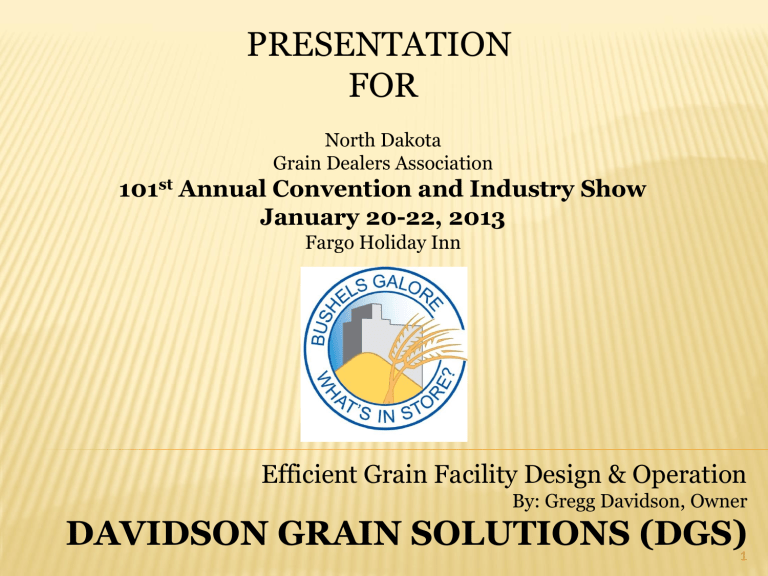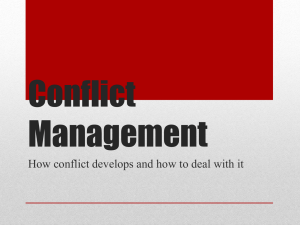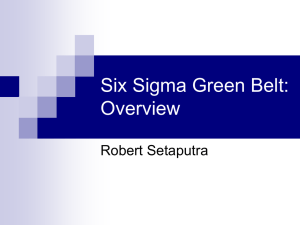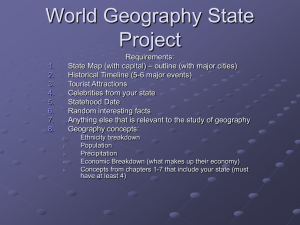Gregg Davidson - North Dakota Grain Dealers Association

PRESENTATION
FOR
North Dakota
Grain Dealers Association
101 st Annual Convention and Industry Show
January 20-22, 2013
Fargo Holiday Inn
Efficient Grain Facility Design & Operation
By: Gregg Davidson, Owner
DAVIDSON GRAIN SOLUTIONS (DGS)
1
DAVIDSON GRAIN SOLUTIONS (DGS)
• Troubleshooting
• Plant Engineering
• Master-Planning
• Construction Management
• Start-up & Training
Maddock, ND ● Moorhead, MN ● Plymouth, MN
2
THE GOAL TODAY…
For me:
Offer up some new ideas and some proven reminders to:
Change/improve your existing facility successfully
Build a new addition or new facility
Operate your facility better and safer
Maintain your facility better and safer
For you:
Look for new ideas that you can incorporate back home
Reinforce old ideas that are proven
Think of a question or comment
Relax and enjoy the presentation followed by questions
3
6 STEPS TO IMPROVE YOUR FACILITY
Step 1 - Conceptual Design
Step 2 - Front End Engineering Design
Step 3 - Detailed Design
Step 4 - Construction
Step 5 - Start-Up & Warranty
Step 6- Safety Devices, Operation, & Maintenance
Bucket Elevator Legs
Drag Conveyors
Belt Conveyors
4
STEP 1 - CONCEPTUAL DESIGN
Process flow diagram (front gate thru exit gate)
Changes to existing flow or developing new flow
Crops handled and annual bushels per crop
Total annual bushels handled
Operating hours non-harvest and harvest
In-bound truck/rail weighing and sampling
Out-bound truck/rail weighing and sampling
Receiving system(s) truck/rail flow rate
Storage type and capacities
Grain temperature monitoring
Drying system flow rate/moisture reduction
5
CONCEPTUAL DESIGN – PAGE 2
In-house transfer flow rate
Rail load-out flow rate and allowed loading time w/0 penalty
Truck load out flow rate
Equipment by-pass/duplication options
Sanitation goals
Automation goals
Operator control room scheme
Special requirements for inspectors and required certifications
Other key business goals
Other key customer goals
Interference with existing operations
Future growth considerations
Cadillac or nice Chevrolet ($$$)
Potential concerns by neighbors and public
6
CONCEPTUAL DESIGN – PAGE 3
Site plan (outside front gate thru outside exit gate)
3D for aerial perspective
2D for details
Existing structures, roads, and landmarks
Off-site improvements (drainage, public roads, traffic flow)
Site grading and drainage
Utilities (electrical, gas, water, sewer, fire, communications)
7
CONCEPTUAL DESIGN – PAGE 4
Roads and parking (traffic flow, customers, employees, surfaces)
Emergency vehicle access
Structures
Railroad
Landscape areas
Low maintenance areas
Site security (lighting, gates & fence, guard shack, public locks)
Other key business and customer goals
Construction staging area
Interference with existing operations
Future growth considerations
Cadillac or nice Chevrolet ($$$)
Potential concerns by neighbors and public
8
STEP 2 – FRONT END ENGINEERING DESIGN
Organizational chart
Show owners, designers, contractors, & subs
Show overall responsibilities for each
Show method of project delivery for each
Design – build
Design – bid - build
Consider shared document website for info sharing
Project schedule
Weather impact
Project budget
Weather impact
9
FRONT END ENGINEERING DESIGN – PAGE 2
Permits
City
County
Watershed district
State
Federal
Railroad
Utilities (electrical, gas, water, sewer, fire, comm.)
Determine electrical classification for all areas
10
FRONT END ENGINEERING DESIGN – PAGE 3
Land ownership
Clear title
Easements
Site survey report
Existing topography, buildings, roads, and landmarks
Geotechnical report
Locate multiple soil borings directly under key areas
Estimated total soil settlement
Estimated differential soil settlement
Estimated water table during construction & operation
Determine geotech’s ability to perform material testing
11
FRONT END ENGINEERING DESIGN – PAGE 4
Operational safety
Explosion prevention and venting
Fall protection guarding
Running equipment guarding
Secondary egress
Others specific to the facility
Determine construction management needs
Evaluate internal skills, experience, and time available
Consider outside help for:
Conceptual and Front End Engineering Design
Bid package development
Over-sight of Construction, Start-Up, & Warranty 12
STEP 3 – DETAILED DESIGN
Civil package
Site plan
Railroad plan
Structures and machinery package
Process flow diagram
General arrangements
Concrete structural
Steel structural
Miscellaneous
Equipment list
Electrical package
Controls package
13
STEP 4 - CONSTRUCTION
Construction safety
Excavations
Fall protection
Ladders and scaffolding
Crane lifts
Electrocution
Personal protective equipment
Other hazards specific to the project
14
CONSTRUCTION – PAGE 2
Construction contract
Format (design-build, build only)
Project schedule
Responsibility for final engineering
Construction safety
Responsibility for material testing and review
Insurance and bonding
Retainage
Liquidated damages
Start-up
What triggers final payment?
Warranty
15
CONSTRUCTION – PAGE 3
Owner mobilization
Pre-mobilization meeting (per organizational chart)
Construction staking
Temporary electrical service
Temporary water service (fire protection?)
Temporary communications
Contractor mobilization
Critical meetings and inspections
Daily, weekly, monthly
Progress photos
Final punch list (substantial completion)
16
STEP 5 – START-UP & WARRANTY
Operator training materials
Hard copies & electronic version of manuals
Operator training
Start-up plan to SAFELY meet phased goals
Process equipment
Process safety devices and instrumentation
Dust collection balancing
Building-related devices and instrumentation
Engineered silo/bin loading plan
17
START-UP & WARRANTY – PAGE 2
Final written acceptance by Owner
Contractor de-mobilization
As-built documentation
Hard copies & electronic version of as-built drawings & specs
Post-project de-briefing meeting
Problems and praises
Future maintenance and project needs
Potential reference and marketing testimony
Issue final payment
Warranty period (solve problems together)
18
STEP 6 – BUCKET ELEVATOR LEGS
Recommended safety devices
Speed monitor on boot shaft for alarm and shutdown
Belt alignment switch on each side of boot
Bearing temperature sensor on each side of boot
Belt alignment switch on each side of head
Bearing temperature sensor on each side of head
Plug switch at leg discharge
Guarding over all exposed shafts
Explosion panels
19
BUCKET ELEVATOR LEGS – PAGE 2
Operation
Install outside if possible
Maximum 650 feet per minute (fpm) belt speed = 7mph
Wear liner selection based on crops, bushels, & years
Spout feeding leg inlet plays huge role in filling cups
Height of leg inlet with respect to boot shaft is critical
Class II drive with backstop capable of starting leg under full load
Reduced voltage starter (soft start) capable of starting leg under full load
20
BUCKET ELEVATOR LEGS – PAGE 3
Maintenance
Replace head pulley lagging if belt will not track or crown
(1/8” per foot from edge to center of pulley) is gone
Belt replacement guideline based on 1.5% stretch
Example: 100 ft tall leg = 200 ft belt x 1.5% = 3 ft = 1.5 ft take up
Replace bearings based on frequent inspection
Watch/listen for changes
21
STEP 6 – DRAG CONVEYORS
Recommended safety devices
Speed monitor on tail shaft for alarm and shutdown
Slack/tight chain switch on tail
Plug switch at conveyor discharge
Guarding over all exposed shafts
22
DRAG CONVEYORS – PAGE 2
Operation
150 to 180 feet per minute (fpm) chain speed = 2 mph
Wear liner selection based on crops, bushels, & years
Class II drive capable of starting drag under full load
Reduced voltage starter (soft start) capable of starting drag under full load
23
DRAG CONVEY0RS – PAGE 3
Maintenance
Replace bearings, sprockets, and chain based on frequent inspection
Watch/listen for changes
24
STEP 6 – BELT CONVEYERS
Recommended safety devices
Speed monitor on tail shaft for alarm and shutdown
Belt alignment switch on each side of tail
Bearing temperature sensor on each side of tail
Belt alignment switch on each side of head
Bearing temperature sensor on each side of head
Plug switch at conveyor discharge
Guarding over all exposed shafts
25
BELT CONVEYERS – PAGE 2
Operation
Maximum 700 feet per minute (fpm) belt speed = 7 mph
Wear liner selection based on crops, bushels, and years
Spout feeding the loader plays huge role in feeding belt
Class II drive capable of starting conveyor under full load
Reduced voltage starter (soft start) capable of starting conveyor under full load
Side wall inspection doors recommended
26
BELT CONVEY0RS – PAGE 3
Maintenance
Inspect tail section often for grain re-loading
Replace head pulley lagging if belt will not track
Belt replacement guideline based on 1.5% stretch
Replace bearings based on frequent inspection
Watch/listen for changes
27
QUESTIONS? COMMENTS?
Thank you and Go Bison!
Efficient Grain Facility Design & Operation
By: Gregg Davidson, Owner
DAVIDSON GRAIN SOLUTIONS (DGS)
28







